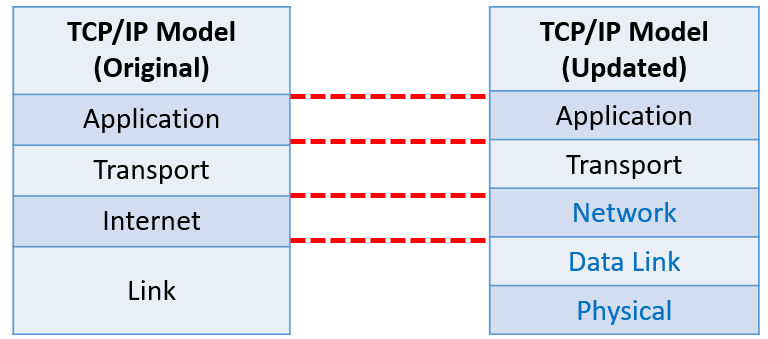This topic is to discuss the following lesson:
Actually the TCP layer contains port data, encompassing the transport and session.
Hey Rene. Please help me here. I’m getting confused with OSI and TCP/IP. From Wendell Odom Book it says TCP/IP in the model being used in networking while OSi is just used for referencing but on the above article you are saying TCP/IP was never popular and OSi is the one being used.
Hi Joel,
The OSI model and TCP/IP stack are both “theoretical” models to describe the different layers of networking.
IP (or IPv6) and TCP are used everywhere but when we talk about the different layers, normally everyone talks about the 7 layers of the OSI model and not the 4 layers of the TCP/IP stack.
Does that make sense?
Rene
Hi,
I was thinking that OSI is just a reference model, a blue print. TCP/IP model is an implementation of current internet architecture.
Am I wrong?
Regards,
Durga Prasad.
Durga,
OSI and TCP/IP are both models, and TCP/IP is a currently implemented model. An interesting fact is that there was, at one time, an actual OSI protocol that followed the 7 layer model of OSI. The OSI protocol (obviously) lost out to TCP/IP.
Thank you Andhrew.
Regards,
Durga
Hi Rene\Andrew,
So are you saying both OSI and TCP\IP models were introduced as a reference models(theoretical model) by 2 different organizations and later TCP\IP became popular to implement in real world . Couldn’t they try to implement OSI stack ? I see only TCP\IP stack in all the computers in today’s world.
Hi Sreenath,
The OSI model was meant to be a standard for how we connect different devices together and created ISO (International Organization for Standardization). It describes different layers and how encapsulation works etc.
IP and TCP were developed as part of the DoD (Department of Defense) ARPA project and TCP/IP happens to the most used stack nowadays. We had other protocols like Appletalk and IPX in the past.
ISO also created their own “IP” equivalent which you can still witness if you work with IS-IS. You can read a bit about it here:
Why TCP/IP became the most dominant protocol is a good question. If you google for this, you’ll probably find a variety of different stories. Similar to how we now have blu-rays instead of HD DVD, how VHS won over Betamax, etc.
Hello guys,
I’ve read in the ICND1 100-105 book that the TCP/IP model has an updated version, with Internet layer becoming Network layer and Link layer split in Data Link and Physical layer (just like in the OSI model)
Is this new version became a de facto or we can still consider the original TCP/IP model (RFC 1122) ?
I’m just wondering if in the exam they refer to the original or updated version?
Thanks.
Hello Sorin
Yes, this is Cisco’s attempt to promote this new TCP/IP model in their curriculum, and to be honest, it’s not a bad idea. When we talk about networking, we usually use the OSI model layer names and numbers. We talk about a L2 or L3 switch, or L2 functionality as switching and L3 functionality as routing, and L4 operation as TCP sessions and UDP datagrams. The problem is that all of these technologies are not actually modeled around the OSI model but around the TCP/IP model. So according to the TCP/IP model, switching is L1, routing is L2 and TCP sessions are L3. However, we never refer to the layers of the TCP/IP model with numbers so that we don’t get confused with those of the OSI model.
Now Cisco is attempting to normalize the TCP/IP model with the OSI model by splitting the Link layer into the Data Link and Physical layers and renaming the Internet layer as the Network layer as shown below.
In my opinion this is a good idea because it clarifies the role of the various parts of Ethernet and IP communications by using the actual model after which they have been standardized, which is the TCP/IP model. And this clarifies its relationship with the OSI model as well.
Now this has not generally been adopted by the telecom industry at large nor has it been defined in any RFC, but for the time being it is restricted to Cisco courses and documentation. I’m hoping that it will overflow into the more widespread conscience of the networking world as a whole. For the exams however, not to worry as any indication of layers of models will make it quite clear as to what they are asking for, whether it’s the updated TCP/IP model, the original or the OSI.
I hope this has been helpful!
Laz
Thank you for your explanation, make sense of what you say.
I just hope I won’t get confused. There are three network models (ISO, TCP/IP, TCP/IP updated) that more or less look the same and they were supposed to define a common standard.
Anyway thanks again.
Regards,
Soren.
Hello Abd
This is something that cannot be done. The TCP/IP stack model has this order of layers by definition. If you were to conceptually switch the two layers, nothing would function correctly. Remember that the network layer provides end to end unreliable communication between hosts while the transport layer provides end to end reliable communication between applications on hosts. You require the transport layer to be encapsulated into the network layer in order for network communication to function.
I hope this has been helpful!
Laz
Thank you Lazaros Agapides for your explanation it is very clear ![]() .
.
